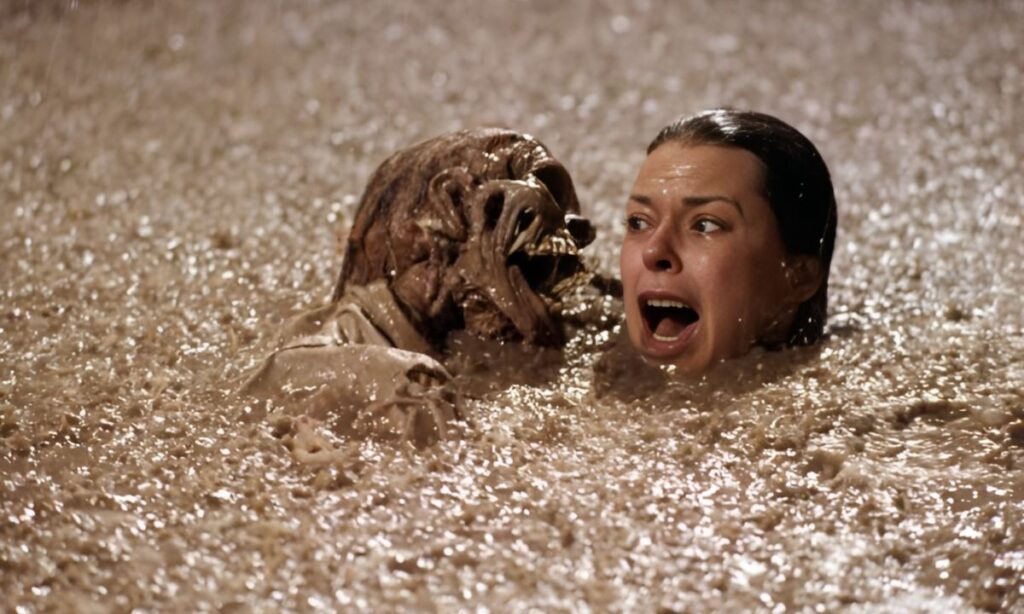In the annals of horror film history, few movies have left as lasting an impression as the 1982 classic “Poltergeist.” Directed by Tobe Hooper and produced by Steven Spielberg, this supernatural thriller captivated audiences with its groundbreaking special effects and bone-chilling storyline.
But behind the scenes lurked a secret more disturbing than any ghostly apparition on screen: the use of real human skeletons as props. This revelation sent shockwaves through the film industry and ignited a fierce debate about ethical filmmaking practices. I
n this deep dive, we’ll explore the controversial decision to use authentic human remains in “Poltergeist,” its impact on the cast and crew, and the lasting effects on the movie industry as a whole.
Origins of the Claim
The whispers about real skeletons in “Poltergeist” began as hushed rumors in Hollywood circles. Initially dismissed as urban legend, these claims gained traction when crew members started corroborating the story. The film community was abuzz with speculation, and fans were left wondering: had one of their favorite horror films crossed an ethical line in pursuit of authenticity?
As the rumors spread, they took on a life of their own. Internet forums and fan sites became hotbeds of discussion, with amateur sleuths poring over every frame of the film for clues. The controversy even spawned its own mythology, with some claiming that the use of real skeletons had cursed the production.
Unveiling the Truth about the Authentic Skeletons
As the controversy grew, the truth emerged like a specter from the shadows. Special effects artists confirmed that real human skeletons were indeed used in several key scenes, most notably the infamous swimming pool sequence. These weren’t just any props – they were actual human remains, sourced from medical supply companies that provided skeletons for educational purposes.
Why use real skeletons? The decision was rooted in a quest for realism. In the early 1980s, creating convincing fake skeletons was both expensive and challenging. Real bones were cheaper and, ironically, more readily available. This chilling fact highlights the ethical quandaries faced by filmmakers striving for authenticity in an era before advanced CGI.
The use of real skeletons wasn’t limited to background props. In one particularly unsettling revelation, it was disclosed that the skeletons were used in scenes where actors physically interacted with them. This raised further questions about the potential psychological impact on the performers, especially the younger cast members.
The Unveiled Proof
Evidence supporting the use of real skeletons in “Poltergeist” includes:
- Testimonies from special effects artists like Craig Reardon
- Behind-the-scenes photos showing authentic human remains on set
- Detailed accounts of how the skeletons were prepared and used in filming
- Comparisons of film footage with known characteristics of real and fake skeletons
A side-by-side comparison of the film’s skeletons with known prop skeletons of the time reveals stark differences in texture, coloration, and overall realism. Experts in forensic anthropology have weighed in, confirming that the skeletal remains seen in the film exhibit characteristics consistent with real human bones.
Insights from Spielberg and Crew Responses
Steven Spielberg, the film’s producer and co-writer, initially remained tight-lipped about the controversy. However, as pressure mounted, he addressed the issue, expressing regret over the decision while emphasizing the different standards of the time.
“Back then, it was just a way to achieve a look, but today, we’d never do that. It was a different time with different sensibilities.” – Steven Spielberg
Other crew members echoed this sentiment, highlighting the industry’s evolving ethical standards and the pressure to create convincing effects on tight budgets. Some defended the decision, arguing that it was a common practice at the time and that the remains were treated with respect.
Tobe Hooper, the film’s director, offered a different perspective:
“We were young and eager to push boundaries. In retrospect, we should have considered the ethical implications more carefully.”
These conflicting accounts underscore the complexity of the issue and the changing attitudes towards ethical filmmaking over the decades.
The Influence on the Film Industry
The “Poltergeist” skeleton controversy sent ripples through Hollywood, prompting discussions about ethics in filmmaking. It raised important questions:
- Where do we draw the line between art and exploitation?
- How do we balance the pursuit of realism with respect for human dignity?
- What responsibilities do filmmakers have to their audience and to society at large?
These debates led to significant changes in industry practices, with many productions implementing stricter ethical guidelines for prop usage and special effects. The controversy also sparked a broader conversation about the treatment of human remains in entertainment and other industries.
Contemporary Film Production and Ethical Standards
Today’s film industry operates under vastly different ethical standards. The use of human remains in productions is now widely considered taboo, with filmmakers relying on advanced special effects and CGI to create realistic skeletal imagery.
Modern guidelines emphasize:
- Respect for human dignity
- Transparency in production methods
- Ethical sourcing of all props and materials
- Consideration of cultural sensitivities
- Psychological support for cast and crew when dealing with disturbing content
The “Poltergeist” controversy serves as a cautionary tale, reminding filmmakers of the importance of ethical considerations in their craft. It has become a case study in film schools, used to teach aspiring directors and producers about the responsibilities that come with creative power.
The Disturbing Trend of Fatalities After Production
In a bizarre twist, “Poltergeist” became associated with a series of tragic deaths among its cast members, leading to speculation about a “Poltergeist curse.” While skeptics dismiss these claims as coincidence, the deaths of young actress Heather O’Rourke and others involved in the film have added to its mystique and controversy.
| Actor | Role | Year of Death | Age | Cause of Death |
| Dominique Dunne | Dana Freeling | 1982 | 22 | Murdered by ex-boyfriend |
| Heather O’Rourke | Carol Anne | 1988 | 12 | Septic shock |
| Julian Beck | Kane | 1985 | 60 | Stomach cancer |
| Will Sampson | Taylor | 1987 | 53 | Post-operative kidney failure |
While these tragic events aren’t directly linked to the use of real skeletons, they’ve contributed to the film’s dark legacy and the ongoing fascination with its production. Some have even suggested that the use of real human remains somehow “cursed” the production, though there’s no scientific evidence to support such claims.
Exploring Controversy of the 1982 movie poltergeist used real skeletons as – tymoff
When the truth about the skeletons came to light, public reaction was swift and largely negative. Many viewers felt deceived and disturbed by the revelation. The film industry, caught off guard by the backlash, scrambled to address concerns and reassure the public.
Fan clubs and horror film enthusiasts were divided. Some defended the filmmakers’ commitment to realism, while others felt betrayed by what they saw as a gross violation of ethical standards. The controversy even led to calls for boycotts of future releases associated with the filmmakers involved.
Legal and Ethical Considerations
The use of human remains in “Poltergeist” raised complex legal and ethical questions. While not strictly illegal at the time, the practice existed in a grey area of entertainment law. Today, such actions would likely face significant legal challenges and ethical scrutiny.
Legal experts have since debated the implications:
- Potential violations of laws governing the treatment of human remains
- Questions of consent and the rights of the deceased
- International laws regarding the transportation and use of human remains
These discussions have led to more stringent regulations in the film industry and a greater awareness of the legal ramifications of using controversial materials in productions.
The Enduring Impact of the Departed Actors
Despite the controversy, “Poltergeist” remains a beloved classic, due in no small part to the performances of its cast. The untimely deaths of several actors have only added to the film’s mystique, with fans viewing their performances through a bittersweet lens.
The legacy of these actors extends beyond “Poltergeist”:
- Dominique Dunne’s death led to increased awareness of domestic violence
- Heather O’Rourke’s passing sparked discussions about child actors’ welfare
- Julian Beck and Will Sampson are remembered for their contributions to theater and Native American representation, respectively
Their performances in “Poltergeist” continue to be celebrated, serving as a testament to their talent and the film’s enduring impact on popular culture.
The Emotional Toll on Cast and Crew
Working with real human remains took an emotional toll on the cast and crew. Some reported feeling uneasy or even experiencing nightmares. The knowledge that they were handling actual human bones created a somber atmosphere that permeated the set.
Cast members have shared their experiences:
- JoBeth Williams, who played the mother, expressed discomfort with the pool scene
- Craig T. Nelson, the father, spoke of a “heavy energy” on set
- Zelda Rubinstein, who played the psychic, claimed to have sensed “presences” during filming
These accounts highlight the psychological impact of using real human remains in filmmaking, raising questions about the duty of care producers owe to their cast and crew.
The Aftermath of Using Real Skeletons and an On-Set Exorcism
In a stranger-than-fiction twist, reports surfaced of an exorcism performed on the “Poltergeist” set. Whether this was a genuine attempt to ward off evil spirits or a publicity stunt remains unclear, but it added another layer to the film’s dark legacy.
The alleged exorcism has become part of “Poltergeist” lore, with various accounts circulating:
- Some claim it was performed by a Native American shaman
- Others attribute it to a Catholic priest brought in by concerned crew members
- Skeptics argue it was a marketing ploy to generate buzz for the film
Regardless of its veracity, the story of the on-set exorcism underscores the unsettling atmosphere surrounding the production and the lasting impact of the decision to use real human remains.
Behind the Curtain: The Choice for Authenticity
The decision to use real skeletons wasn’t made lightly. Filmmakers weighed the benefits of authenticity against potential ethical concerns. In the end, the desire for realism won out, a choice that would haunt the production for years to come.
Factors that influenced the decision included:
- Budget constraints limiting options for high-quality fake skeletons
- The drive to create groundbreaking, realistic special effects
- A different cultural attitude towards the use of human remains in the 1980s
- The competitive nature of the horror film industry at the time
This decision-making process reflects the complex interplay of artistic, financial, and ethical considerations in filmmaking, serving as a cautionary tale for future productions.
The Wider Impact on Movie Making
The “Poltergeist” controversy highlighted the need for greater cultural sensitivity in filmmaking. It sparked discussions about the treatment of human remains across different cultures and the importance of respecting diverse beliefs in the pursuit of entertainment.
This increased awareness has led to:
- More diverse representation in film crews and consultancy roles
- Greater consideration of cultural taboos and sensitivities in storytelling
- The development of guidelines for depicting or using culturally significant artifacts
These changes represent a positive shift towards more inclusive and respectful filmmaking practices.
Encouraging Transparency and Responsibility
In the wake of the scandal, calls for greater transparency in film production grew louder. Today, filmmakers are expected to be more open about their methods and more responsible in their choices.
Industry changes include:
- More detailed disclosures in film credits about production methods
- Increased engagement with audiences through behind-the-scenes content
- Greater accountability for ethical decisions in filmmaking
These practices help build trust with audiences and promote a more ethical approach to entertainment.
Understanding Viewer Anxiety: What Truly Disturbs Audiences?
The revelation about real skeletons in “Poltergeist” tapped into deep-seated anxieties about death and the treatment of human remains. It forced viewers to confront uncomfortable truths about the entertainment they consume and the lengths to which filmmakers might go for realism.
Psychological studies have explored:
- The impact of knowing “behind the scenes” information on viewer experience
- How the use of real human remains affects audience perception of horror films
- The role of authenticity in creating fear and unease in viewers
These insights have influenced how filmmakers approach horror and realism, leading to more nuanced and psychologically informed storytelling techniques.
Advancements in Special Effects Technology and Their Influence
Since 1982, special effects technology has advanced by leaps and bounds. Modern filmmakers can create incredibly realistic skeletal imagery without resorting to controversial methods. This progress has made the ethical dilemmas faced by the “Poltergeist” team largely obsolete.
Key advancements include:
- Photorealistic CGI capable of creating lifelike skeletal structures
- 3D printing technology for creating detailed physical props
- Motion capture techniques for animating skeletal movements
These technologies allow filmmakers to achieve the realism they desire without compromising ethical standards.
Delving into the Fascination with Horror and Realism in Society
The “Poltergeist” skeleton controversy speaks to a broader societal fascination with horror and the macabre. It raises questions about why we seek out frightening experiences in entertainment and how far we’re willing to go for an authentic scare.
Sociological perspectives on this phenomenon include:
- The role of horror in processing real-world anxieties
- The appeal of transgressive experiences in safe, controlled environments
- The evolution of horror tropes and audience expectations over time
Understanding these aspects of human psychology helps contextualize the decisions made during the production of “Poltergeist” and the public reaction to the controversy.
The Impact of the Poltergeist Controversy on Future Filmmaking
The legacy of “Poltergeist” and its use of real skeletons continues to influence filmmaking today. It serves as a reminder of the power of cinema to shock and disturb, and the responsibility that comes with that power.
Lasting impacts include:
- More rigorous ethical review processes for film productions
- Increased scrutiny of special effects methods and prop sourcing
- A renewed focus on the psychological well-being of cast and crew in horror films
These changes have contributed to a more conscientious approach to filmmaking, especially in the horror genre.
The 1982 Movie Poltergeist Used Real Skeletons As – Tymoff Final Words
The use of real skeletons in “Poltergeist” remains a controversial chapter in film history. It stands as a testament to the lengths filmmakers once went to for realism and a cautionary tale about the ethical boundaries of art. As we continue to push the envelope in storytelling and special effects, the lessons learned from “Poltergeist” serve as a vital reminder of the importance of ethical filmmaking practices.
In the end, “Poltergeist” is more than just a horror classic – it’s a complex story of ambition, ethics, and the unforeseen consequences of artistic choices. Its legacy continues to haunt the film industry, challenging us to consider the true cost of authenticity in art. As we move forward, the “Poltergeist” controversy reminds us to balance our pursuit of cinematic excellence with a profound respect for human dignity and ethical considerations.







